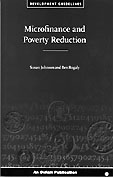Table of Contents
Acknowledgements
Introduction
1 Current debates in microfinance
1.1 Subsidised credit provision
1.2 The move to market-based solutions
1.3 Making use of social collateral
1.4 Savings
1.5 Can microfinance interventions reduce poverty?
1.6 Financial interventions and social
change
1.7 Treading carefully in microfinance
interventions
2 Informal financial services
2.1 Introduction
2.2 User-owned informal financial services
2.3 Informal financial services for profit
2.4 Turning the informal into the formal
2.5 What can be learned from informal finance?
2.6 Deciding when and how to intervene
2.7 Filling the gaps
2.8 Promotion: an alternative strategy for NGOs
2.9 Summary and conclusions
3 The design of savings and credit schemes for poor people
3.1 Introduction
3.2 Targeting savings and credit to poor people
3.3 Women as users of financial services
3.4 Lending through groups
3.5 Savings
3.6 Forms of loan
3.7 Loan disbursement and repayment schedules
3.8 Interest rates
3.9 Integrating financial services with other activities
3.10 Summary and conclusions
4 Financial performance and sustainability
4.1 Introduction
4.2 Managing and assessing financial performance
4.3 Financial sustainability
4.4 Managerial and organisational sustainability
4.5 Summary and conclusions
5 Assessing impact
5.1 Introduction
5.2 The difficulties of assessing impact
5.3 Innovations in impact assessment
5.4 Learning and adaptability
5.5 Summary and conclusions
6 Case studies
6.1 Introducing the case studies
6.2 Union Regional de Apoyo Campesino
(URAC), Mexico
6.3 SUNGI Development Foundation, Pakistan
6.4 Ladywood Credit Union, UK
6.5 ACTIONAID in the Gambia
6.6 Casa Campesina Cayambe, Ecuador
7 Conclusions
Annex 1 Table 1 Six microfinance institutions
Annex 2 Repayment rate and arrears rate
References
|
 Small scale financial services, such as savings and credit facilities, are increasingly seen
as effective means of poverty reduction. Microfinance and Poverty Reduction, a
new book published by Oxfam in conjunction with ACTIONAID, examines the
successes and pitfalls of such schemes across the globe and the lessons learnt,
promoting debate around the issue. Small scale financial services, such as savings and credit facilities, are increasingly seen
as effective means of poverty reduction. Microfinance and Poverty Reduction, a
new book published by Oxfam in conjunction with ACTIONAID, examines the
successes and pitfalls of such schemes across the globe and the lessons learnt,
promoting debate around the issue.
Although microfinance can increase incomes and contribute to household and
individual security, the authors emphasise that credit is not a panacea for eradicating poverty. The continuing debate about the issue and different approaches are highlighted in case studies from the UK, Mexico, Pakistan, Ecuador and The Gambia.
The book recommends an overall approach to deciding whether, and in what ways,
small scale financial interventions can be useful and relevant to poor people in different
contexts.
About the authors:Susan Johnson is an economist and has worked for ACTIONAID since 1991. She is currently researching microfinance issues. Ben Rogaly is a socio-economist and former policy adviser to Oxfam UK. He now teaches development studies at the University of East Anglia, UK.
8.95 UK pounds
136pp, Paperback, April 1997, Oxfam
ISBN 0 85598 369 8
Contact addresses:
Oxfam c/o BEBC Distribution
PO Box 1496
Parkstone, Poole, Dorset BH12 3YD, UK
Tel: (44) (0)1202 715555
Fax: (44) (0)1202 715556
Order this book from
Amazon.com
Hari Srinivas - hsrinivas@gdrc.org
 Return to the New Publications Page Return to the New Publications Page
 Return to the Virtual Library on Microcredit Return to the Virtual Library on Microcredit
|
 Small scale financial services, such as savings and credit facilities, are increasingly seen
as effective means of poverty reduction. Microfinance and Poverty Reduction, a
new book published by Oxfam in conjunction with ACTIONAID, examines the
successes and pitfalls of such schemes across the globe and the lessons learnt,
promoting debate around the issue.
Small scale financial services, such as savings and credit facilities, are increasingly seen
as effective means of poverty reduction. Microfinance and Poverty Reduction, a
new book published by Oxfam in conjunction with ACTIONAID, examines the
successes and pitfalls of such schemes across the globe and the lessons learnt,
promoting debate around the issue.
 Return to the New Publications Page
Return to the New Publications Page Return to the Virtual Library on Microcredit
Return to the Virtual Library on Microcredit